The global industrial noise control market is projected to reach USD 12.7 billion by 2035, recording an absolute increase of USD 5.82 billion over the forecast period. The market is valued at USD 6.9 billion in 2025 and is set to rise at a CAGR of 6.3% during the assessment period.
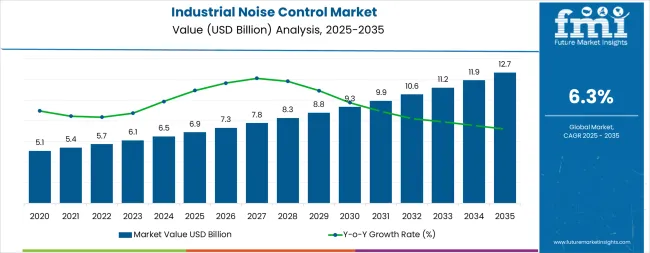
The overall market size is expected to grow by nearly 1.8 times during the same period, supported by increasing demand for workplace safety solutions worldwide, driving demand for efficient noise reduction systems and increasing investments in manufacturing and industrial facility upgrades globally. High installation costs and complex retrofitting requirements for existing facilities may pose challenges to market expansion.
Between 2025 and 2030, the industrial noise control market is projected to expand from USD 6.9 billion to USD 9.34 billion, resulting in a value increase of USD 2.46 billion, which represents 42.3% of the total forecast growth for the decade.
This phase of development will be shaped by rising demand for worker safety compliance and regulatory requirements, product innovation in acoustic technologies and smart monitoring systems, as well as expanding integration with IoT-enabled noise monitoring and automation initiatives. Companies are establishing competitive positions through investment in advanced noise reduction formulations, efficient production solutions, and strategic market expansion across manufacturing, construction, and industrial applications.
From 2030 to 2035, the market is forecast to grow from USD 9.34 billion to USD 12.7 billion, adding another USD 3.36 billion, which constitutes 57.7% of the overall ten-year expansion. This period is expected to be characterized by the expansion of hybrid noise control systems, including advanced active-passive combinations and integrated smart monitoring solutions tailored for specific industry requirements, strategic collaborations between acoustic manufacturers and end-user industries, and an enhanced focus on production efficiency and environmental compliance.
The growing emphasis on workplace safety optimization and regulatory adherence will drive demand for advanced, high-performance industrial noise control solutions across diverse industrial applications.
| Metric | Value |
|---|---|
| Market Value (2025) | USD 6.9 billion |
| Market Forecast Value (2035) | USD 12.7 billion |
| Forecast CAGR (2025-2035) | 6.3% |
The industrial noise control market grows by enabling manufacturers to achieve superior workplace safety and regulatory compliance in various applications, ranging from heavy manufacturing to construction sites. Industrial manufacturers face mounting pressure to protect worker health and meet safety standards, with noise control solutions typically providing significant noise reduction compared to unprotected environments, making industrial noise control systems essential for compliant manufacturing operations.
The manufacturing industry's need for maximum worker protection and operational efficiency creates demand for advanced noise reduction solutions that can minimize harmful exposure, enhance productivity, and ensure consistent performance across diverse environmental conditions.
Government initiatives promoting workplace safety standards and occupational health regulations drive adoption in manufacturing, construction, and power generation applications, where noise levels have a direct impact on worker safety and operational compliance.
High installation costs and the complexity of achieving consistent noise control across different facility types may limit adoption rates among cost-sensitive manufacturers and developing regions with limited technical expertise.
The market is segmented by material type, product type, application, end use, and region. By material type, the market is divided into polymer & composite, glass, metal, fabric, and others. By product type, the market is categorized into flexible, rigid, and vibration isolation systems.
Based on application, the market is divided into internal noise control and external noise control. By end use, the market is segmented into manufacturing & heavy industry, power generation & utility, building & construction, transportation, food & beverages, healthcare & pharma, mining, and others. Regionally, the market is divided into North America, Europe, Asia Pacific, and other key regions.
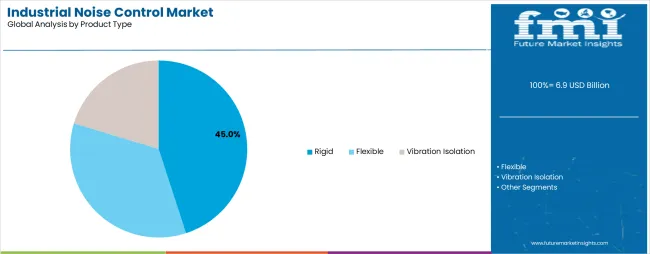
The rigid systems segment represents the fastest-growing category in the industrial noise control market, projected to grow at a CAGR of 7.2% through 2035. This advanced technology category encompasses formulations featuring sophisticated acoustic designs, including enclosures, silencers, ceiling baffles, test chambers, soundproof walls, and panels that enable superior noise attenuation performance and enhanced durability characteristics.
The rigid segment's growth leadership stems from its exceptional acoustic performance capabilities, with systems capable of achieving significant noise reduction across industrial frequencies while maintaining consistent performance and environmental resistance across diverse operating conditions.
The flexible systems segment maintains substantial market presence, serving manufacturers who require adaptable noise control solutions for variable applications. These formulations offer reliable performance for general-purpose acoustic applications while providing sufficient noise reduction to meet basic performance requirements in manufacturing and construction applications. The vibration isolation segment addresses structure-borne noise through specialized pads, mounts, and equipment bases.
Key technological advantages driving the rigid segment include:
Internal noise control applications dominate the industrial noise control market with approximately 71.5% market share in 2025, reflecting the critical role of workplace noise management in protecting worker health and supporting regulatory compliance initiatives. The internal segment's market leadership is reinforced by increasing workplace safety requirements, government occupational health policies, and rising demand for productivity optimization that directly correlates with acoustic comfort quality.
The external noise control segment represents applications focused on managing noise emissions from industrial facilities to surrounding environments. This segment benefits from growing demand for community relations and environmental compliance that meet stringent regulatory requirements in industrial zones.
Key market dynamics supporting application growth include:
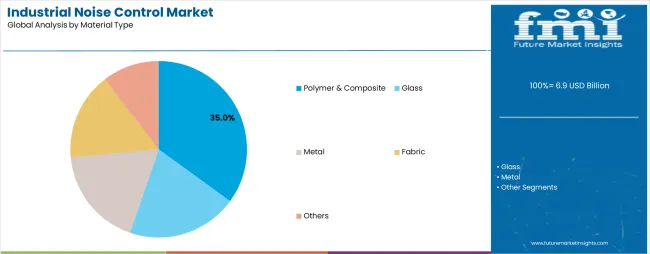
Polymer & composite materials dominate the material type segment with a CAGR of 6.9% through 2035, reflecting their excellent acoustic absorption properties, lightweight design, and adaptability to diverse industrial applications. These materials, including polyurethane foams and elastomers, are heavily utilized in manufacturing and construction due to their superior performance characteristics and environmental compliance capabilities.
Glass and metal materials serve specific applications requiring structural integrity and high-temperature resistance, though their heavier nature and higher costs limit widespread adoption. Fabric materials are primarily used in flexible applications and temporary installations, offering moderate growth potential through specialized acoustic textile solutions.
Manufacturing & Heavy Industry represents the largest end-use segment with a CAGR of 6.7% through 2035, driven by the sector's inherently high noise generation from machinery, assembly lines, and production processes. This segment includes automotive, electronics & electrical equipment, machinery, metals, cement, and textile manufacturing, all requiring comprehensive noise control solutions for worker protection and regulatory compliance.
Power generation & utility facilities demonstrate steady demand due to the continuous operation of loud equipment and regulatory requirements for both worker safety and community noise management. Building & construction applications show growing adoption as awareness of acoustic safety and productivity benefits increases across project sites.
The market is driven by three concrete demand factors tied to safety and compliance outcomes. First, workplace safety regulations and occupational health standards create increasing demand for comprehensive noise control solutions, with global manufacturing expansion projected to grow by 10-15% annually in major markets worldwide, requiring specialized acoustic solutions for maximum worker protection. Second, industrial facility modernization and productivity enhancement drive the adoption of advanced noise control systems, with manufacturers seeking significant improvements in acoustic comfort and operational efficiency. Third, technological advancements in materials science and acoustic engineering enable more effective and durable noise control solutions that reduce maintenance requirements while improving long-term performance and cost-effectiveness.
Market restraints include high installation costs that can impact project budgets and implementation timelines, particularly during periods of capital constraint or budget limitations affecting comprehensive facility upgrades. Technical complexity in system design and installation poses another significant challenge, as achieving optimal noise control across different industrial environments and operational conditions requires specialized expertise and quality control systems, potentially causing project delays and increased implementation costs. Retrofitting challenges in existing facilities create additional complexity for manufacturers, demanding innovative solutions and compliance with varying operational requirements and facility constraints.
Key trends indicate accelerated adoption in Asia-Pacific markets, particularly China and India, where rapid industrial expansion and manufacturing growth drive comprehensive noise control system development. Technology advancement trends toward smart system integration with enhanced monitoring, IoT connectivity, and predictive maintenance capabilities enable next-generation product development that addresses multiple performance requirements simultaneously. The market thesis could face disruption if alternative noise management technologies or significant changes in industrial facility designs minimize reliance on traditional noise control solutions.
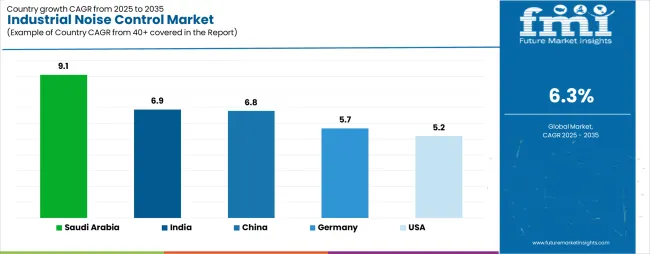
| Country | CAGR (2025-2035) |
|---|---|
| Saudi Arabia | 9.1% |
| India | 6.9% |
| China | 6.8% |
| Germany | 5.7% |
| United States | 5.2% |
The industrial noise control market is gaining momentum worldwide, with Saudi Arabia taking the lead thanks to massive industrial expansion and government-backed infrastructure development programs. Close behind, India benefits from growing manufacturing initiatives and industrial facility modernization programs, positioning itself as a strategic growth hub in the Asia-Pacific region.
China shows strong advancement, where integration of advanced noise control technologies strengthens its role in global manufacturing and industrial equipment supply chains. Germany demonstrates steady progress through advanced engineering capabilities and stringent workplace safety requirements.
Meanwhile, the USA stands out for its established regulatory framework and continuous facility upgrades in existing industrial applications. Together, Saudi Arabia and India anchor the global expansion story, while the rest build stability and diversity into the market's growth path.
The report covers an in-depth analysis of 40+ countries, the top-performing countries are highlighted below.
Saudi Arabia demonstrates the strongest growth potential in the industrial noise control market with a CAGR of 9.1% through 2035. The country's leadership position stems from massive industrial diversification projects, government-backed Vision 2030 modernization programs, and aggressive manufacturing development targets, driving the adoption of high-performance noise control systems.
Growth is concentrated in major industrial regions, including the Eastern Province, Riyadh Province, and NEOM development areas, where petrochemical facilities and manufacturing companies are implementing advanced noise control solutions for enhanced worker safety and international competitiveness.
Distribution channels through established engineering contractors and direct manufacturer relationships expand deployment across industrial manufacturing facilities and construction project sites. The country's economic diversification strategy provides policy support for advanced industrial technologies, including high-performance noise control system adoption.
Key market factors:
In Mumbai, Delhi, Chennai, and Bangalore, the adoption of industrial noise control systems is accelerating across manufacturing facilities and construction projects, driven by workplace safety targets and government Make in India initiatives. The market demonstrates strong growth momentum with a CAGR of 6.9% through 2035, linked to comprehensive industrial capacity expansion and increasing focus on worker safety compliance solutions.
Indian manufacturers are implementing advanced noise control systems and monitoring platforms to enhance workplace safety while meeting growing demand for manufactured goods in domestic and export markets. The country's industrial development policies create continued demand for high-performance noise control solutions, while increasing emphasis on occupational health drives adoption of advanced acoustic technologies and safety systems.
China's advanced industrial sector demonstrates comprehensive implementation of industrial noise control systems, with documented case studies showing significant noise reduction improvements in manufacturing applications through optimized acoustic solutions.
The country's manufacturing infrastructure in major industrial centers, including Guangdong, Jiangsu, Zhejiang, and Shandong, showcases integration of advanced noise control technologies with existing production systems, leveraging expertise in industrial engineering and precision manufacturing.
Chinese manufacturers emphasize efficiency standards and worker protection, creating demand for high-performance noise control solutions that support productivity initiatives and regulatory requirements. The market maintains strong growth through focus on technology innovation and manufacturing competitiveness, with a CAGR of 6.8% through 2035.
Key development areas:
Germany's advanced industrial infrastructure demonstrates sophisticated implementation of industrial noise control systems, with documented case studies showing significant workplace safety improvements in manufacturing applications through optimized noise reduction solutions.
The country's manufacturing infrastructure in major industrial centers, including North Rhine-Westphalia, Bavaria, Baden-Württemberg, and Lower Saxony, showcases integration of advanced acoustic technologies with existing facility systems, leveraging expertise in mechanical engineering and precision manufacturing.
German manufacturers emphasize quality standards and regulatory compliance, creating demand for high-performance noise control solutions that support workplace safety initiatives and operational requirements. The market maintains steady growth through focus on technology innovation and export competitiveness, with a CAGR of 5.7% through 2035.
Market characteristics:
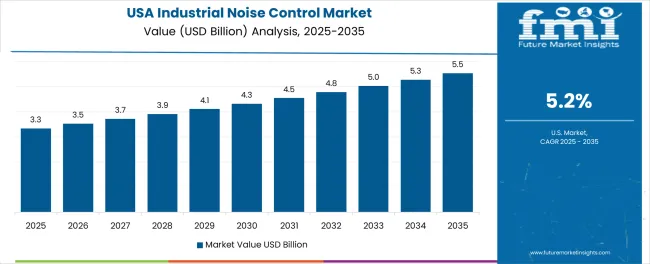
The United States market leads in regulatory compliance based on integration with established workplace safety standards and sophisticated occupational health applications for enhanced worker protection characteristics. The country shows solid potential with a CAGR of 5.2% through 2035, driven by facility upgrade programs and advanced manufacturing initiatives across major industrial regions, including the Midwest, Southeast, Texas, and California.
American manufacturers are adopting advanced noise control systems for regulatory compliance and worker safety optimization, particularly in states with strict occupational health requirements and advanced manufacturing facilities requiring superior workplace protection. Technology deployment channels through established safety equipment distributors and direct manufacturer relationships expand coverage across manufacturing and industrial facility installations.
Leading market segments:
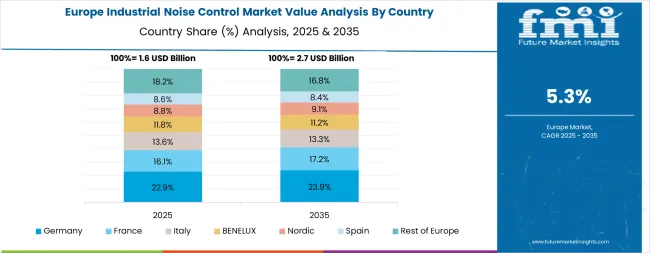
The industrial noise control market in Europe is projected to grow from USD 1.72 billion in 2025 to USD 2.58 billion by 2035, registering a CAGR of 4.1% over the forecast period. Germany is expected to maintain its leadership position with a 32.4% market share in 2025, declining slightly to 31.8% by 2035, supported by its extensive industrial manufacturing infrastructure and major engineering centers, including Munich, Stuttgart, and Frankfurt production facilities.
The United Kingdom follows with a 19.2% share in 2025, projected to reach 19.6% by 2035, driven by comprehensive industrial facility upgrade programs and advanced manufacturing initiatives implementing noise control technologies. France holds a 16.1% share in 2025, expected to maintain 15.8% by 2035 through ongoing facility modernization and industrial technology development.
Italy commands a 14.3% share, while Spain accounts for 9.8% in 2025. The Rest of Europe region is anticipated to gain momentum, expanding its collective share from 8.2% to 8.9% by 2035, attributed to increasing noise control adoption in Nordic countries and emerging Eastern European manufacturing facilities implementing advanced safety programs.
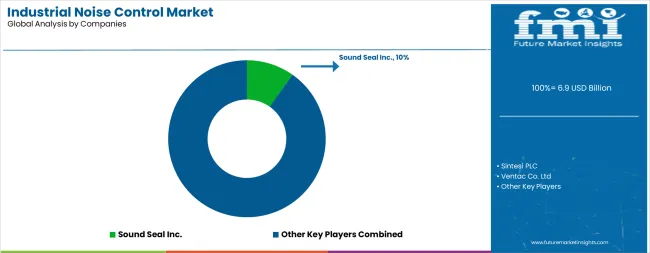
The industrial noise control market features approximately 20-25 meaningful players with moderate concentration, where the top three companies control roughly 30-35% of global market share through established technology platforms and extensive industrial relationships. Competition centers on acoustic performance quality, system reliability, and application expertise rather than price competition alone.
Market leaders include Sound Seal Inc., Sintesi PLC, and Ventac Co. Ltd, which maintain competitive advantages through comprehensive acoustic solution portfolios, global manufacturing networks, and deep expertise in industrial noise control and workplace safety sectors, creating high switching costs for customers. These companies leverage research and development capabilities and ongoing technical support relationships to defend market positions while expanding into adjacent industrial and construction applications.
Challengers encompass Saint Gobain and Pyrotek, which compete through specialized noise control solutions and strong regional presence in key manufacturing markets. Technology specialists, including Merford Holding B.V, ArtUSA Industries Inc., and Durr Universal Inc., focus on specific acoustic technologies or vertical applications, offering differentiated capabilities in application techniques, customization services, and specialized performance characteristics.
Regional players and emerging acoustic solution providers create competitive pressure through cost-effective solutions and rapid customization capabilities, particularly in high-growth markets including India and China, where local presence provides advantages in customer service and regulatory compliance. Market dynamics favor companies that combine advanced acoustic technologies with comprehensive technical support offerings that address the complete noise control lifecycle from system design through ongoing performance optimization.
Industrial noise control systems represent specialized acoustic solutions that enable manufacturers to achieve significant noise reduction compared to unprotected environments, delivering superior workplace safety and regulatory compliance with comprehensive sound attenuation across industrial frequencies in demanding applications.
With the market projected to grow from USD 6.9 billion in 2025 to USD 12.7 billion by 2035 at a 6.3% CAGR, these noise control systems offer compelling advantages - enhanced worker protection, customizable acoustic properties, and operational efficiency - making them essential for manufacturing & heavy industry applications (largest end-use segment), internal noise control (71.5% market share), and industrial facilities seeking alternatives to inadequate noise management that compromises worker safety through excessive exposure.
Scaling market adoption and technological advancement requires coordinated action across workplace safety policy, industrial standards development, acoustic solution manufacturers, end-user industries, and occupational health investment capital.
How Governments Could Spur Local Production and Adoption?
How Industry Bodies Could Support Market Development?
How OEMs and Technology Players Could Strengthen the Ecosystem?
How Suppliers Could Navigate the Shift?
How Investors and Financial Enablers Could Unlock Value?
| Item | Value |
|---|---|
| Quantitative Units | USD 6.9 billion |
| Material Type | Polymer & Composite, Glass, Metal, Fabric, Others |
| Product Type | Flexible (Sound Curtains, Acoustic Foam, Acoustic Blankets, Sound Absorbers), Rigid (Enclosures, Silencers, Ceiling Baffles, Test Chambers, Soundproof Walls, Panels, Others), Vibration Isolation (Isolation Pads, Isolation Mounts, Machinery Pads, Equipment Bases, Others) |
| Application | Internal Noise Control, External Noise Control |
| End Use | Manufacturing & Heavy Industry (Automotive, Electronics & Electrical Equipment, Machinery, Metals, Cement, Textile), Power Generation & Utility, Building & Construction, Transportation, Food & Beverages, Healthcare & Pharma, Mining, Others |
| Regions Covered | Asia Pacific, Europe, North America, Latin America, Middle East & Africa |
| Country Covered | Saudi Arabia, India, China, Germany, USA, and 40+ countries |
| Key Companies Profiled | Sound Seal Inc., Sintesi PLC, Ventac Co. Ltd, Saint Gobain, Pyrotek, Merford Holding B.V, ArtUSA Industries Inc., Durr Universal Inc. |
| Additional Attributes | Dollar sales by material type, product type, application, and end use categories, regional adoption trends across Asia Pacific, Europe, and North America, competitive landscape with acoustic solution providers and technology integrators, manufacturing facility requirements and specifications, integration with workplace safety initiatives and industrial systems, innovations in noise control technology and application systems, and development of specialized formulations with performance and durability capabilities. |
The global industrial noise control market is estimated to be valued at USD 6.9 billion in 2025.
The market size for the industrial noise control market is projected to reach USD 12.7 billion by 2035.
The industrial noise control market is expected to grow at a 6.3% CAGR between 2025 and 2035.
The key product types in industrial noise control market are polymer & composite, glass, metal, fabric and others.
In terms of product type, rigid segment to command 45.0% share in the industrial noise control market in 2025.






Our Research Products

The "Full Research Suite" delivers actionable market intel, deep dives on markets or technologies, so clients act faster, cut risk, and unlock growth.

The Leaderboard benchmarks and ranks top vendors, classifying them as Established Leaders, Leading Challengers, or Disruptors & Challengers.

Locates where complements amplify value and substitutes erode it, forecasting net impact by horizon

We deliver granular, decision-grade intel: market sizing, 5-year forecasts, pricing, adoption, usage, revenue, and operational KPIs—plus competitor tracking, regulation, and value chains—across 60 countries broadly.

Spot the shifts before they hit your P&L. We track inflection points, adoption curves, pricing moves, and ecosystem plays to show where demand is heading, why it is changing, and what to do next across high-growth markets and disruptive tech

Real-time reads of user behavior. We track shifting priorities, perceptions of today’s and next-gen services, and provider experience, then pace how fast tech moves from trial to adoption, blending buyer, consumer, and channel inputs with social signals (#WhySwitch, #UX).

Partner with our analyst team to build a custom report designed around your business priorities. From analysing market trends to assessing competitors or crafting bespoke datasets, we tailor insights to your needs.
Supplier Intelligence
Discovery & Profiling
Capacity & Footprint
Performance & Risk
Compliance & Governance
Commercial Readiness
Who Supplies Whom
Scorecards & Shortlists
Playbooks & Docs
Category Intelligence
Definition & Scope
Demand & Use Cases
Cost Drivers
Market Structure
Supply Chain Map
Trade & Policy
Operating Norms
Deliverables
Buyer Intelligence
Account Basics
Spend & Scope
Procurement Model
Vendor Requirements
Terms & Policies
Entry Strategy
Pain Points & Triggers
Outputs
Pricing Analysis
Benchmarks
Trends
Should-Cost
Indexation
Landed Cost
Commercial Terms
Deliverables
Brand Analysis
Positioning & Value Prop
Share & Presence
Customer Evidence
Go-to-Market
Digital & Reputation
Compliance & Trust
KPIs & Gaps
Outputs
Full Research Suite comprises of:
Market outlook & trends analysis
Interviews & case studies
Strategic recommendations
Vendor profiles & capabilities analysis
5-year forecasts
8 regions and 60+ country-level data splits
Market segment data splits
12 months of continuous data updates
DELIVERED AS:
PDF EXCEL ONLINE
Noise Control System Market Analysis - Size, Share, and Demand Forecast Outlook 2025 to 2035
Noise Control Enclosures Packaging Market
Industrial Control Network Modules Market Size and Share Forecast Outlook 2025 to 2035
Industrial Control Transformer Market
Industrial Pump Control Panels Market Trends & Forecast 2025 to 2035
Industrial Robot Controller Market Size and Share Forecast Outlook 2025 to 2035
Industrial Access Control Market Size and Share Forecast Outlook 2025 to 2035
Industrial Temperature Controller Market Analysis - Size & Industry Trends 2025 to 2035
Demand for Industrial Control Network Modules in UK Size and Share Forecast Outlook 2025 to 2035
Factory Automation And Industrial Controls Market Growth - Trends & Forecast 2025 to 2035
Industrial Grade Electrochemical CO Sensor Market Size and Share Forecast Outlook 2025 to 2035
Industrial Bench Scale Market Size and Share Forecast Outlook 2025 to 2035
Noise Reduction Tactical Headset Market Size and Share Forecast Outlook 2025 to 2035
Control Network Modules Market Size and Share Forecast Outlook 2025 to 2035
Industrial Low Profile Floor Scale Market Size and Share Forecast Outlook 2025 to 2035
Industrial Sand Mill Market Size and Share Forecast Outlook 2025 to 2035
Industrial Precision Oven Market Size and Share Forecast Outlook 2025 to 2035
Industrial Water Chiller for PCB Market Size and Share Forecast Outlook 2025 to 2035
Industrial & Commercial HVLS Fans Market Size and Share Forecast Outlook 2025 to 2035
Industrial Wired Routers Market Size and Share Forecast Outlook 2025 to 2035

Thank you!
You will receive an email from our Business Development Manager. Please be sure to check your SPAM/JUNK folder too.
Chat With
MaRIA